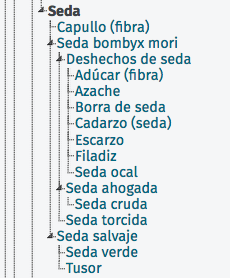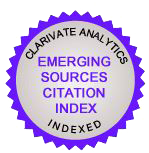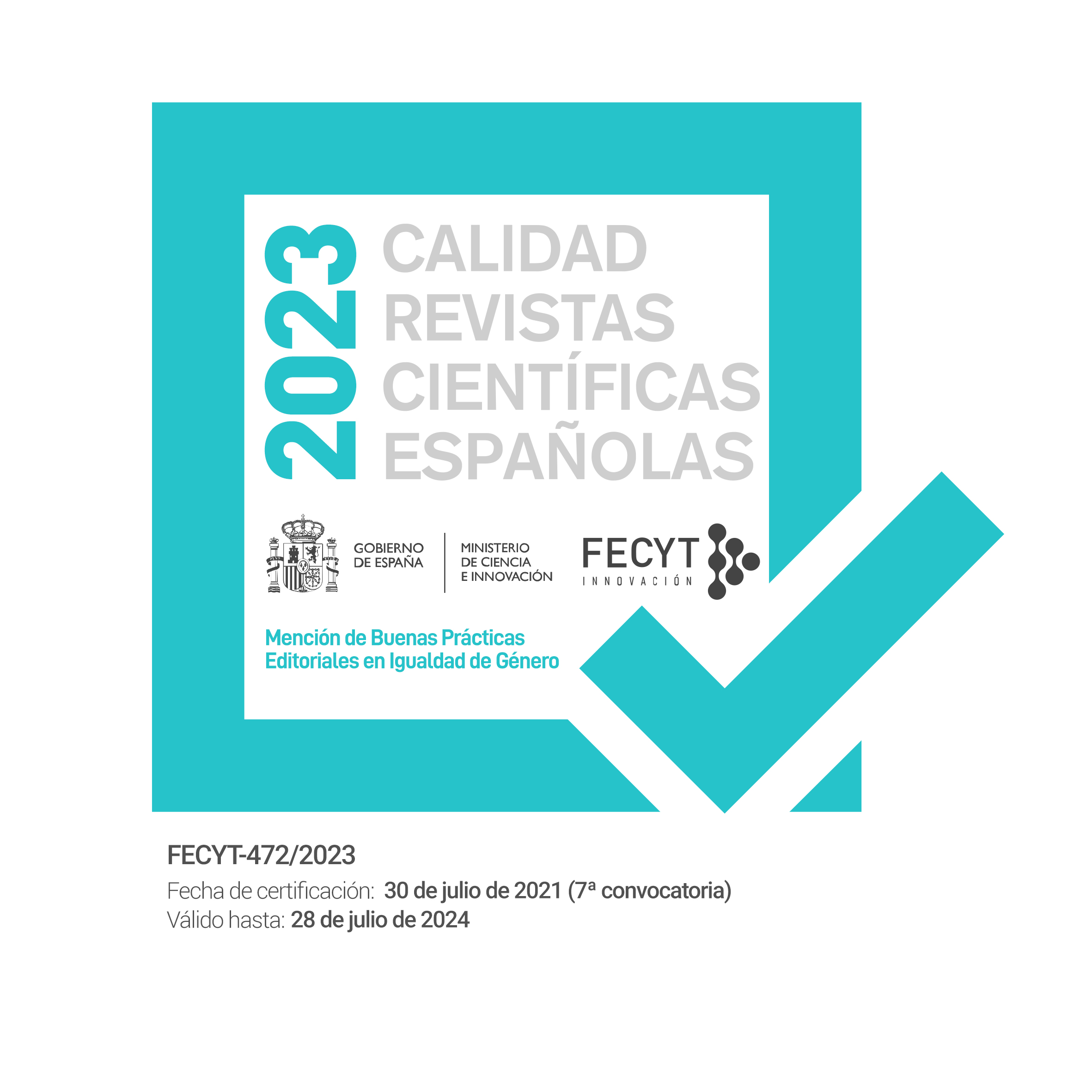Palabras tejidas: método y uso de un tesauro multilingüe de la seda
DOI:
https://doi.org/10.30827/erph.vi29.22359Palabras clave:
Tesauro, Seda, Patrimonio inmaterial, Normalización, Tejido, Tejeduría, Artesania, Industrial textilResumen
El patrimonio europeo de la seda es un patrimonio integral que abarca tanto bienes materiales (telares, tejidos, hilos, etc.) como un importante patrimonio inmaterial lingüístico. Su importancia como patrimonio es indudable, pero aunque la seda ha tejido Europa y se sigue utilizando en numerosos contextos, la tejeduría tradicional está en riesgo por la pérdida gradual de artesanos que salvaguarden el conocimiento ancestral. Además, la seda sigue siendo relevante para las personas que experimentan conexiones vivas, personales y sociales con este patrimonio, el cual está vinculado a tantas historias de vida y relatos colectivos que ha generado numerosos vocablos propios. El modo en se han catalogado los bienes asociados a la seda es muy heterogénea debido a la falta de normalización de los catálogos de los museos que los custodian. Es por ello que el vocabulario del patrimonio de la seda procede de múltiples fuentes que se han mezclado a través del tiempo y el espacio, dando como resultado que la interoperabilidad de estos datos sea extremadamente complicada. Para abordar estos retos, el proyecto SILKNOW asumió el reto de crear un tesauro multilingüe que es la base de otras herramientas del proyecto, normaliza el vocabulario del tejido sedero y rescata el patrimonio inmaterial asociado a este. Este artículo presenta los fundamentos de la realización de este tesauro y su relación con la salvaguarda del patrimonio material y sobre todo, inmaterial.
Descargas
Citas
AMIN, A., HILDEBRAND, M., VAN OSSENBRUGGEN, J. & HARDMAN, L. (2010). “Designing a thesaurus-based comparison search interface for linked cultural heritage sources”, Proceedings of the 15th International Conference on Intelligent User Interfaces, IUI’10, pp. 249-258. doi: <https://doi.org/DOI: https://doi.org/10.1145/1719970.1720005>
ANDREU PINTADO, J. (2014). “Arqueología en directo: canales de comunicación y transferencia de resultados en la investigación sobre patrimonio arqueológico: la ciudad romana de los Bañales (un castillo en Zaragoza)”. En Visibilidad y divulgación de la investigación desde las humanidades digitales. Experiencias y proyectos, Pamplona, Universidad de Navarra, pp. 17-41.
BACA, M. (2004). “Fear of Authority? Authority Control and Thesaurus Building for Art and Material Culture Information”, Cataloging & Classification Quarterly, n.38 (3–4), pp. 143-151. https://doi.org/10.1300/J104v38n03_13
BAKHSHI, H., SCHNEIDER, P. & WALKER, C. (2008). Arts and humanities research and innovation. Arts and Humanities Research Council, Bristol. En línea: https://www.researchgate.net/publication
/299595412_Arts_and_Humanities_Research_in_the_Innovation_System_The_UK_Example. Consulta: [04.04.2021]
BENITO, P. (2018). “La introducción por primera vez en España del telar con mecanismo Jacquard en 1819: un gran reto para renovar un antiguo gremio”. En La formación artística: creadores, historiadores, espectadores. Editorial de la Universidad de Cantabria, pp. 314-322.
BENITO, P. (2003). “La seda en Europa meridional desde el Renacimiento hasta la aparición del mecanismo Jacquard”. En Textil e indumentaria [Recurso electrónico]: materias, técnicas y evolución: 31 de marzo al 3 de abril de 2003, Facultad de Geografía e Historia de la UCM (pp. 150-164). EL Grupo Español del IIC (International Institute for Conservation of Historic and Artistic Works).
BLANCO, J. (2010). “Fashion at the museum: successful experiences with student curators”, Museum Management Curatorship, n. 25, pp. 199–217. https://doi.org/10.1080/09647771003737323.
CHEN, S., BENET MARTÍNEZ, V., HARRIS BOND, M. (2008). “Bicultural identity, bilingualism, and psychological adjustment in multicultural societies: Immigration-based and globalization-based acculturation”, Journal of Personality, n. 76 (4), 803838. 10.1111/j.1467-6494.2008.00505.x
CAMPBELL, R. & CHRISTIAN D. (2003). “Directions in research: intergenerational transmission of heritage languages”. Heritage Language Journal, n. 1, pp. 11–14. En línea: <https://www.international.ucla.edu/africa/article/3893>. [Consulta: 10.04.2021]
CAPRIOLI, C. (2002). “Multilinguismo e diversità linguistica nell'Unione Europea: L'esperienza del sitio web «Multilinguismo? Sì, grazie! della Rappresentanza della Commissione europea a Milano”, Ianua. Revista Philologica Romanica, n 3, pp.156-165. En línea: https://dialnet.unirioja.es/servlet/articulo?codigo=3731369. [Consulta: 05.03.2021]
CIETA. 2020. “Vocabulario Técnico Tejidos Español, francés, inglés, italiano”. Lyon: Centre International d’Etude des Textiles Anciens.
ELERA-SAN, HURTADO, A. (2004). “Unión Europea y Multilingüismo”, Revista Española De Derecho Europeo, n. 9, pp. 85-135. En línea: <http://www.revistasmarcialpons.es/revistaespanoladerechoeuropeo/article/view/234>. Consulta: [15.04.2021]
EUROPEAN COMMISSION (2011). Proposal for a directive of the European Parliament and of the council amending directive 2003/98/EC on re-use of public sector information.
FRANCH, R. (1990). La comercialización de la seda valenciana a finales del Antiguo Régimen: el «contraste» de la ciudad de Valencia. Revista de Historia Economica-Journal of Iberian and Latin American Economic History, n. 8 (2), pp. 271-304.
GALCERÁN ESCOBET, V. (1960). Tecnología del tejido, Tomo primero: teoría de tejidos. Tarrasa: Editograf Pina.
GALLEGO PELLEGRÍN, J. (2002). “El multilingüismo en la UE ante el reto de la ampliación, El día de Europa, presente y futuro de la Unión Europea”, en I Jornadas en Conmemoración del Día de Europa de la Universidad Pontificia Comillas de Madrid, Madrid, pp. 45-60.
GARCÍA-LUIS, V., MCDONALD, H. and HUERTAS MIGUS, L. (2011). Multilingual Interpretation in Science Centers and Museums. Association of Science-Technology Centers, Washington, D.C. and the Exploratorium, CA: San Francisco. http://www.astc.org/resource/equity/Multilingualism%20Report_Final.pdf
GARGALLO LÓPEZ, B. & SUÁREZ RODRÍGUEZ, J. (2003). “La integración de las nuevas tecnologías de la información y la comunicación en la escuela: Factores relevantes”. Education in the knowledge society (EKS), n. 3 (1). En línea: <https://campus.usal.es/~teoriaeducacion/rev_numero_03/n3_art_gargallo-suarez.htm> . [Consulta 15.04. 2021]
GARIBAY, C. & STEVEN, Y. (2015). “Redefining multilingualism in museums: A case for broadening our thinking”, Museum & Social Issues, n. 2 (7) doi <https://doi.org/10.1179/1559689314Z.00000000028>
GARIBAY, C. (2009). Palm Springs Art Museum: Bilingual Label Study. Unpublished technical report.
KERSTIN, J., DAVIES, S. (2001). “Multilingual thesauri for the modern world - no ideal solution?”, Journal of Documentation, Volume 57, Number 2, 284-295.
KRAMSCH, C. (2006). “The Multilingual Subject”, International Journal of Applied Linguistics, 16, 97-110.
KUUTMA, K. (2007). “Making Inventories: A Constraint or an Asset?” Regional seminar Principles and Experiences of Drawing up ICH Inventories in Europe, Tallin, pp. 14-15.
JUNCAL, F. (2017). Innovación para el multilingüismo: E-LENGUA. Caracteres: estudios culturales y críticos de la esfera digital, n. 6 (2), pp. 282-297.
LANG, A. (2002). "Allargamento dell’Unione Europea e multilinguismo", pp. 93-106. http://hdl.handle.net/2434/194584
LO BIANCO, J. (2010). The importance of language pólice and multilingualism for cultural diversity. UNESCO: Published by Blackwell Publishing Ltd.
MARTÍNEZ LÓPEZ, M. (2019). “Multilingüismo, inmersión y construcción de identidades nacionales”, en Anaceto Ferrer (coord.) Para una nueva cultura política. pp. 118-121. Madrid: Los Libros de la Catarata.
MORRAL I ROMEU, E., SEGURA I MAS, A., & CATALÁN, X. (1991). La Seda en España. Leyenda, poder y realidad, Barcelona: Lunwerg Editores, 1991.
MOURE, T. (2003). “A batalla das linguas no mundo actual. Multilingüismo e antiglobalización” Grial: revista galega de cultura, n.160, pp. 19-29.
MUÑOZ MARTÍN, F. & VALDIVIESO BLANCO, M. (2013). “Multilingüismo y asimetría en la base terminológica de las instituciones europeas”, Tonos digital: Revista de estudios filológicos, 25.
NAVARRO ESPINACH, G. (2016). La seda en Italia y España (siglos XV-XVI). Arte, tecnología y diseño. Revista Diálogos Mediterrânicos, n.10, pp. 71–91. https://doi.org/10.24858/198
NEELY, L. (2016). “Creating Culture By, With and For the Public”, en Andrea Wallace y Ronan Deazley (cords.) Display At Your Own Risk: An experimental exhibition of digital cultural heritage.
NIELSEN, M. (2004). “Thesaurus Construction: Key Issues and Selected Readings”. Cataloging & Classification Quarterly, n. 37 (3–4), pp. 57–74. doi: https://doi.org/10.1300/J104v37n03_05
PIPLANI, N. (2015). «Fundamentos teóricos de la conservación en la India» Conversaciones, n. 1, pp. 88–96
OWENS, L.A. & COCHRANE, P.A. (2004). «Thesaurus evaluation». Cataloging & classification quarterly, n. 37 (3-4), pp. 87-102.doi: https://doi.org/10.1300/J104v37n03_07
PAVLENKO, A. & BLACKLEDGE, A. (2004). “Introduction: New theoretical approaches to the study of negotiation of identities in multilingual contexts”, en Aneta Pavlenko y Adrian Blackledge (coords.), Negotiation of identities in multilingual contexts: 1–33. Clevedon, UK: Multilingual Matters.
PAVLENKO, A. (2005). Emotions and multilingualism. Cambridge: Cambridge University Press.
PÉREZ, L.DE HEREDIA, M. & DE HIGES ANDINO, I. (2019). “Multilingüismo e identidades: nuevas representaciones, nuevos retos”, MonTI: Monografías de traducción e interpretación, n. 4, pp. 33-55. doi: https://doi.org/10.6035/MonTI.2019.ne4.1
PONI, C., GERVAIS, D., & GERVAIS, P. (1998). Mode et innovation: les stratégies des marchands en soie de Lyon au XVIIIe siècle. Revue d'histoire moderne et contemporaine (1954), n. 45 (3), pp. 589-625.
POULIQUEN, B., STEINBERG, R. IGNAT, C. (2003). “Automatic annotation of multilingual text collections with a conceptual thesaurus”, En: Proceedings of the Workshop 'Ontologies and Information Extraction' at the Summer School 'The Semantic Web and Language Technology - Its Potential and Practicalities' (EUROLAN'2003). Bucharest, Romania, 28 July - 8 August 2003: 9-28. En línea: <https://arxiv.org/abs/cs/0609059> Fecha de acceso: 10 abril 2021.
SANTOS, V. (1975). “Sederia i industrialització. El cas de València (1750-1870)”. Recerques: història, economia, cultura, pp. 111-137.
SCHMITTER, P.C.(2009). “El multilingüismo y el futuro de la política europea”, en: Alfonso Guerra y José Félix Tezanos Tortajada (coords.) La calidad de la democracia: las democracias del siglo XXI, pp. 95-102 Madrid: Sistema.
SMEETS, R. (2004). “Language as a Vehicle of the Intangible Cultural Heritage”. Museum International, n. 56, pp. 156-165 doi:https://doi.org/10.1111/j.1350-0775.2004.00470.x
SMITH, L. (2004). Archeological Theory and the Politics of Cultural Heritage. London: Routledge.
SOLER, Ch. (2020). Weaving Europe: Silk heritage and digital technologies. València: Tirant Lo Blanch.
TAFALLA, M. (2010). “El multilingüismo en la Organización de las Naciones Unidas”. Revista de llengua i dret, 53, pp. 137-162.
TUTS, M. (2007). “Las lenguas como elementos de cohesión social: del multilingüismo al desarrollo de habilidades para la comunicación intercultural”, Revista de educación, n. 343, pp. 35-54.
UNESCO (2003). Oral traditions and expressions including language as a vehicle of the intangible cultural heritage. En: https://ich.unesco.org/en/oral-traditions-and-expressions-00053 [Consulta: 02.12.2021].
VAN PASSEL, E. & RIGOLE, J. (2014). “Fictional institutions and institutional frictions: creative approaches to open GLAMs”, Digital Creativity, n. 25, pp. 203–211. doi: https://doi.org/10.1080/14626268.2014.904363.
VAN STEEN, N. (2012). Europeana Fashion Thesaurus v1. Deliverable 2.3.
WISERUIYA, G. (2018). “Living Heritage”, en Allison Heritage y Jennifer Copithorne (coords.) Sharing Conservation Decisions. Current Issues and Future Strategies, pp. 43–56. Roma: ICCROM.

Descargas
Publicado
Cómo citar
Número
Sección
Licencia
Las/os autoras/es conservan los derechos de autoría y otorgan a la revista el derecho de primera publicación (reproducción, edición, distribución, comunicación pública y exhibición).
Más infomación en Sobre la revista > Aviso de derechos de autor/a

 Profesora titular de la Facultad de Geografía e Historia. Licenciada en Geografía e Historia y Doctora en Historia del Arte de la Universitat de València. Su investigación se centra en el ámbito de la imagen artística, la representación del poder, desde la perspectiva de los estudios visuales y la perspectiva de género, la crítica de arte, la museología y el patrimonio cultural. Tiene reconocidos cuatro sexenios de investigación. Ha realizado investigaciones en centros como la Université Paris 1 Sorbonne, la Università Federico II di Napoli, la Università degli studi di Palermo, el ICCROM (Roma), la Hispanic Society (Nueva York) y el CSIC (Madrid). También ha sido invitada a impartir cursos de postgrado en el Institut de Patrimoine de la Université du Laval de Quebec (Canadá). Miembro del equipo de investigación del proyecto europeo EU-LAC-MUSEUMS: Museums and Community: Conceptos, experiencias y sostenibilidad en Europa, América Latina y el Caribe (Horizonte 2020 de la Unión Europea), y participó en la investigación (en comisión de servicios) sobre patrimonio comunitario en el proyecto europeo Trans-making. Actualmente lidera el proyecto europeo SILKNOW (programa de investigación e innovación Horizonte 2020 de la Unión Europea) y Relecturas, itinerarios culturales en clave de género.
Profesora titular de la Facultad de Geografía e Historia. Licenciada en Geografía e Historia y Doctora en Historia del Arte de la Universitat de València. Su investigación se centra en el ámbito de la imagen artística, la representación del poder, desde la perspectiva de los estudios visuales y la perspectiva de género, la crítica de arte, la museología y el patrimonio cultural. Tiene reconocidos cuatro sexenios de investigación. Ha realizado investigaciones en centros como la Université Paris 1 Sorbonne, la Università Federico II di Napoli, la Università degli studi di Palermo, el ICCROM (Roma), la Hispanic Society (Nueva York) y el CSIC (Madrid). También ha sido invitada a impartir cursos de postgrado en el Institut de Patrimoine de la Université du Laval de Quebec (Canadá). Miembro del equipo de investigación del proyecto europeo EU-LAC-MUSEUMS: Museums and Community: Conceptos, experiencias y sostenibilidad en Europa, América Latina y el Caribe (Horizonte 2020 de la Unión Europea), y participó en la investigación (en comisión de servicios) sobre patrimonio comunitario en el proyecto europeo Trans-making. Actualmente lidera el proyecto europeo SILKNOW (programa de investigación e innovación Horizonte 2020 de la Unión Europea) y Relecturas, itinerarios culturales en clave de género. 














